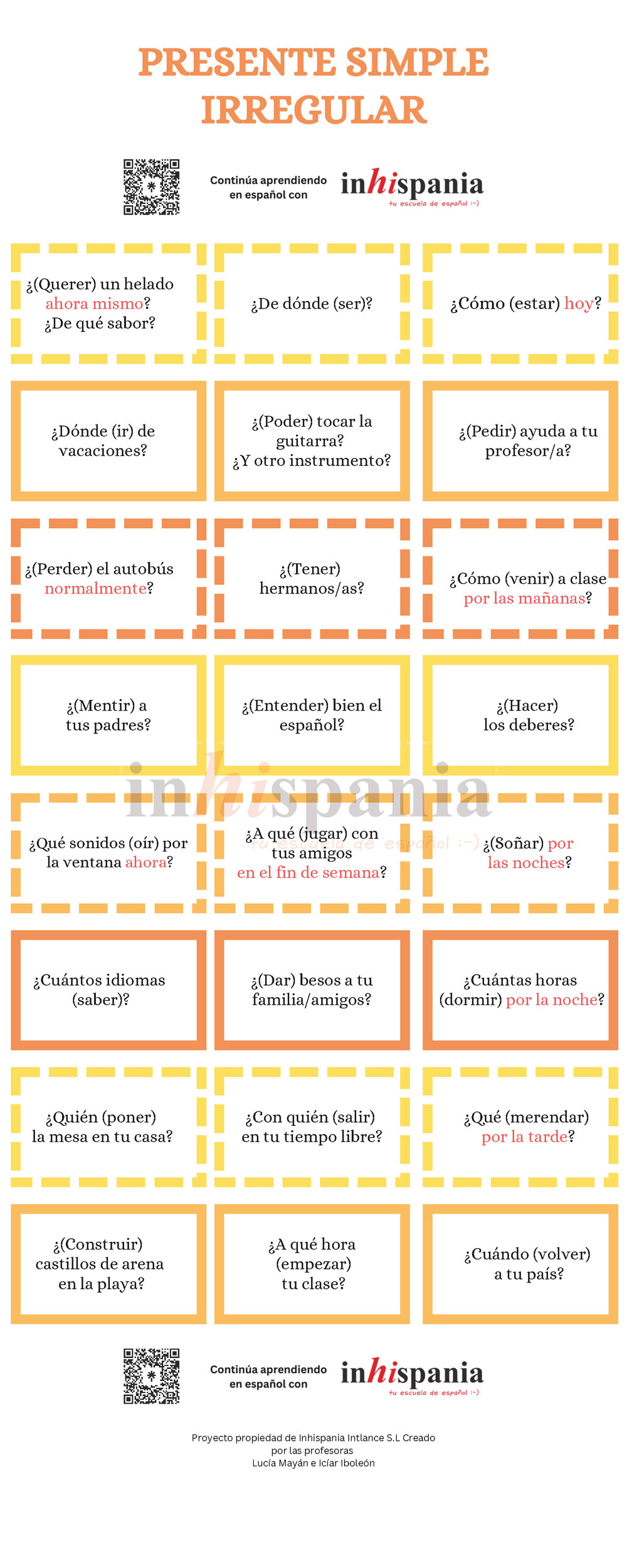Learning a new language is always an exciting and enriching challenge. For foreign students who are learning Spanish, knowing how to use verbs in the present tense is a crucial aspect of everyday communication. While it may seem complicated at first due to the various verb conjugations, irregular forms, and uses, with dedication and some helpful tips, you can improve your command of present tense verbs in Spanish effectively.
1. Understand the Importance of the Present Tense in Spanish
The Present Indicative in Spanish is not only used to describe actions that are happening in the current moment (for which Spanish also uses estar + gerundio), but it is also employed to express habitual actions, general facts, and future events. Understanding this versatility is essential for effective communication.
Actions in the current moment
- El profesor explica (está explicando) la lección en este momento.
The teacher is explaining the lesson right now.
- Ahora me como (me estoy comiendo) una manzana.
I am eating an apple now.
Habitual actions
- Siempre desayuno café por las mañanas.
I always have coffee in the mornings.
- Los lunes, mi hermana va al gimnasio.
On Mondays, my sister goes to the gym.
General facts
- El agua hierve a 100 grados Celsius.
Water boils at 100 degrees Celsius.
- Los seres humanos necesitan agua para vivir.
Humans need water to live.
Future events
- Mañana viajo (= viajaré) a Sevilla para una conferencia.
Tomorrow, I am traveling to Seville for a conference.
- Esta tarde quedo (= quedaré) con mis amigos.
This afternoon, I’m meeting my friends.
2. Learn Basic Regular Verb Conjugations
In Spanish, verbs are conjugated according to the person (yo, tú, él/ella, nosotros, vosotros, ellos/ellas), tense (present, past, future, etc.) and mood (indicative, subjunctive, imperative). Start by learning the basic present indicative conjugations for regular verbs ending in -ar, -er, and -ir.
Hablar (to speak)
- Yo hablo = I speak
- Tú hablas
- Él/Ella habla
- Nosotros/Nosotras hablamos
- Vosotros/Vosotras habláis
- Ellos/Ellas hablan
Comer (to eat)
- Yo como = I eat
- Tú comes
- Él/Ella come
- Nosotros/Nosotras comemos
- Vosotros/Vosotras coméis
- Ellos/Ellas comen
Vivir (to live)
- Yo vivo = I live
- Tú vives
- Él/Ella vive
- Nosotros/Nosotras vivimos
- Vosotros/Vosotras vivís
- Ellos/Ellas viven
3. Learn Irregular Verb Conjugations
Once you’ve mastered regular patterns, move on to the most common irregularities in the present tense. Many affect only the first person singular, others involve stem changes in stressed syllables, and a few are irregular in all persons.
- -cer / -cir (first person singular in -zco): conducir → conduzco, traducir → traduzco, ofrecer → ofrezco.
- Stem changes e→ie / o→ue in stressed forms (except nosotros/vosotros): pensar → pienso, piensas, piensa, pensamos, pensáis, piensan; dormir → duermo, duermes, duerme, dormimos, dormís, duermen.
- Stem change e→i in many -ir verbs: pedir → pido, pides, pide, pedimos, pedís, piden; seguir → sigo, sigues, sigue, seguimos, seguís, siguen.
- -uir (insertion of y except nosotros/vosotros): huir → huyo, huyes, huye, huimos, huís, huyen.
- -go verbs (yo form): tener → tengo, venir → vengo, decir → digo, hacer → hago, poner → pongo, salir → salgo, traer → traigo, oír → oigo.
- Irregular in all persons: ser → soy, eres, es, somos, sois, son; ir → voy, vas, va, vamos, vais, van.


4. Practice with Conjugation Exercises
After learning the core patterns, schedule short daily practice sessions. Mix recognition (choosing the right form) with production (writing or saying full sentences). Track common mistakes and revisit them the next day to consolidate learning.
5. Use Flashcards and Memory Apps
Flashcards or memory apps are excellent for automating forms. Create cards with the infinitive on one side and a targeted person/number on the other, then rotate through all persons. Combine this with spaced repetition for long-term retention. This technique also helps expand vocabulary.
Practice cards: regular present (LINK PDF A1003) and irregular present (LINK PDF A1002).
6. Try to Listen and Speak in Spanish Daily
Oral practice is crucial. Listen to music, podcasts, shows, or series in Spanish to internalize sounds and rhythm. Aim to speak a little every day, ideally with native speakers. Short, frequent conversations build confidence quickly and anchor conjugations in real contexts.
7. Write in Spanish Regularly
Writing helps you slow down and notice forms. Keep a short daily journal, message friends, or draft mini-dialogues. Review your own writing a day later and underline verb forms you’re unsure about, then check them and rewrite a cleaner version.


8. Take Spanish Classes
Structured classes provide feedback and a clear progression. A teacher can correct subtle errors early, explain irregular patterns efficiently, and suggest targeted practice that accelerates results.
9. Participate in Language Exchanges
Language exchanges let you apply what you know while helping someone with your language. Set a simple goal for each session (for example, using five target verbs in conversation) and ask your partner to flag mistakes so you can correct them on the spot.
If you apply these tips with patience and dedication, you will become a more fluent and confident Spanish speaker. If you also have the opportunity to spend time in a Spanish-speaking country, the results can be remarkable. We suggest an intensive course in the heart of Madrid combined with sociocultural activities that include a weekly language exchange. Keep up the good work and master the present tense in Spanish!



